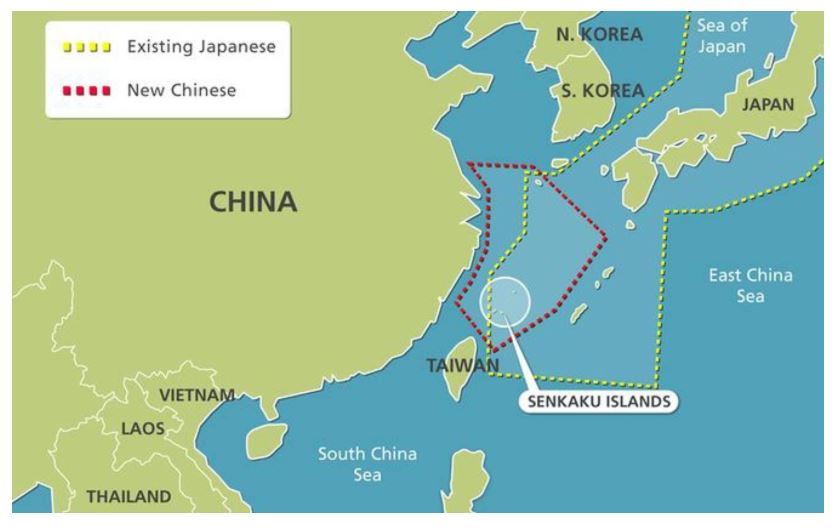The Big Picture- RSTV, UPSC Articles
Senkaku-Diaoyu Islands Dispute
Archives
TOPIC: General Studies 2
- India and its neighbourhood
In News: Japan and China claim the uninhabited islands, known as the Senkaku in Japan and Tiaoyu in China, as their own, but Japan has administered them since 1972.
- The Senkaku/Diaoyu Islands were formally claimed by Japan in 1895. After Japan’s defeat in World War II, the island chain was controlled by the US until 1971 before its return. Since then, Japan has administered the island chains.
- China began to reassert claims over the Senkaku/Diaoyu Islands in the 1970s, citing historic rights to the area. However, Japan does not recognise Chinese claims.
- More recently, there has been a flare up in the region. The Japanese government had protested to China regarding a set of names recently assigned by Beijing to seabed zones in the East China Sea, including the Senkaku/Diaoyu islands.
Geostrategic Importance of the area
- The Senkaku Islands dispute, or Diaoyu Islands dispute, concerns a territorial dispute over a group of uninhabited islands located in East China Sea known as the Senkaku Islands in Japan, the Diaoyu Islands in the China.
- It is roughly to east of mainland China, northeast of Taiwan, west of Okinawa Island, and north of the southwestern end of the Ryukyu Islands.
- They are currently controlled by Japan. But both China and Taiwan claim sovereignty over the islands.
- Oil and gas reserves had been identified under the seabed surrounding the islands and it makes the dispute tougher to resolve.
What does Japan say?
Japan approved plans to change the name of the area covering the Tokyo-controlled Senkaku Islands — known by Taiwan and China as the Diaoyus — from “Tonoshiro” to “Tonoshiro Senkaku”. China said the move is illegal and a “serious provocation”.
- There is a need to remove the administrative confusion with shares the name “Tonoshiro”
- A response to an increased Chinese presence and to protect territorial integrity. Since April, Chinese ships had been spotted by the Japanese coast guard, in the waters close to the Senakakus. The number of Chinese ships have only increased in the last few weeks with four of them sailing in the area even on the day when the bill was passed by the city council
- The defence treaty of Japan and USUSA with Japan boosts confidence of Japan in taking such steps because if Japanese territory is attacked by a foreign power, the United States is obligated to defend it.

Source: Click here
China’s Point of View
Calling the islands its “inherent territories”, China has urged Japan to abide by the spirit of the four-principle consensus, avoid creating new incidents on the Diaoyu Islands issue, and take practical actions to maintain the stability of the East China Sea situation.
Why does China want to control the South China Sea?
- Control of the South China Sea would allow China to dominate a major trade route through which most of its imported oil flows.
- It would also allow China to disrupt, or threaten to disrupt, trade shipments to all countries in East and Southeast Asia — as well as deny access to foreign military forces, particularly the United States.
- The floor of the South China Sea may contain massive oil and natural gas reserves. Sovereignty over the region could give China a level of energy security and independence far beyond what it currently possesses.
Is the Senkakus island chain dispute with Japan is the only territorial and maritime dispute that China has had?
It has island and maritime border disputes with Taiwan, Brunei, Indonesia, Malaysia, Philippines and Vietnam in the South China Sea and its extension. The disputes include islands, reefs, banks and other features in the South China Sea including Spratly Islands (with Vietnam, Philippines, Malaysia, Brunei, Taiwan), Paracel Islands (Vietnam), Scarborough Shoal (Philippines), and Gulf of Tonkin (Vietnam).
More recently…
In the South China Sea, China has moved aircraft onto the man-made islands it has built up; it has sunk one Vietnamese fishing boat and rammed another; it has harassed a Malaysian-chartered survey ship and sent one of its own into waters claimed by Indonesia; in the past few weeks alone, Chinese warplanes have been warned off by Taiwanese fighters at least five times.
Beijing reclassified its island claims in the South China Sea, giving the Spratly/Nansha and Paracel/Xisha islands more prominent status in the country’s governmental hierarchy. Then the clash with India in Ladakh.
Note:
UNCLOS: The United Nations Convention on the Law of the Sea (UNCLOS) is an international agreement which defines the rights and responsibilities of nations with respect to their use of the world’s oceans, establishing guidelines for businesses, the environment, and the management of marine natural resources.
Connecting the Dots:
- Critically examine the impact of South China Sea dispute on India’s aspirations of being a regional super power in South Asia.















